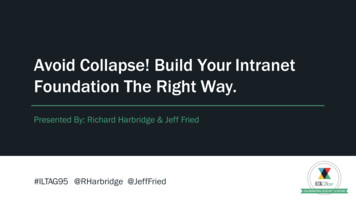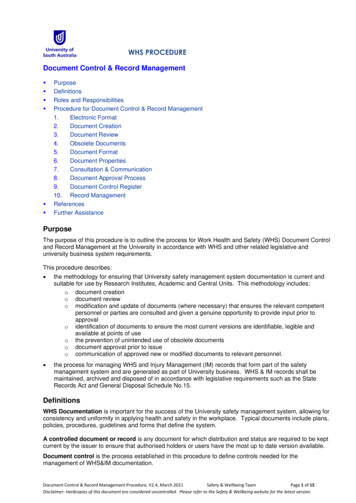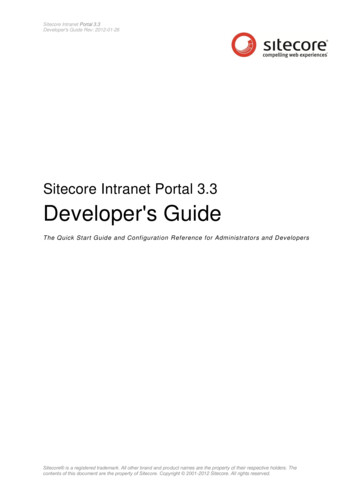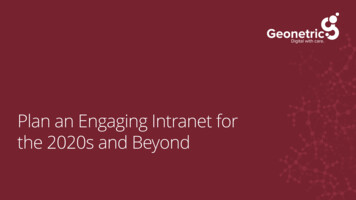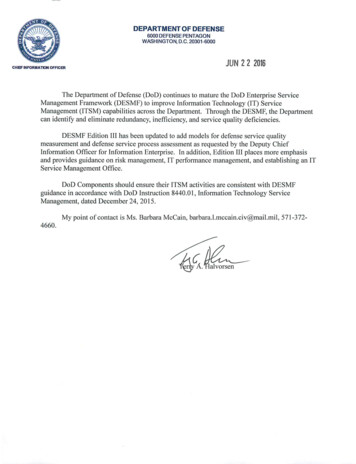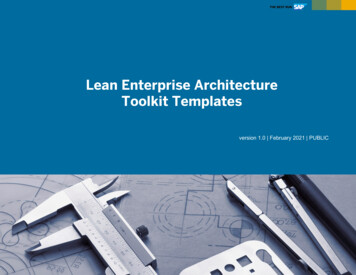
Transcription
OPENEnterprise Architecture FrameworkIT Services / Enterprise Architecture Framework.docx / PUBLISHED / v 3.0Page 1 of 34
OPENEnterprise Architecture FrameworkContents1Introduction . 41.1Background . 41.2Scope . 41.3Purpose . 42Framework Description . 52.1Architecture Process . 52.2Architecture Framework . 72.3Governance. 82.4Assurance . 82.4.1Project Implementation Assurance . 82.4.2Verification and Testing . 92.5Enterprise Architecture Principles . 112.5.1Principles. 122.5.2IT Strategy Drivers . 152.5.3Goals. 152.6Non-Functional Requirements . 162.7Architecture Team . 173Models . 183.1Business Layer . 183.1.1Business Capability Modelling . 183.1.2Information Management Life Cycle . 193.1.3Business Priority. 193.2Application Layer . 203.2.1Application Maps . 203.2.2Portfolio Management . 213.3Technology Layer . 223.3.1Technical Reference Model (TRM) . 223.3.2Standards Information Base (SIB) . 223.4Verticals . 233.4.1Security Architecture . 233.4.2Data Architecture. 233.5Road Maps . 233.6Patterns . 24Glossary . 25References . 25APPENDIX A.Ontology . 26APPENDIX B.Standard Agenda for Architecture Compliance Reviews . 28APPENDIX C.Strategic Reference . 29APPENDIX D.Process Comparison . 33APPENDIX E.Archimate Diagram Notation Key . 34IT Services / Enterprise Architecture Framework.docx / PUBLISHED / v 3.0Page 2 of 34
OPENEnterprise Architecture FrameworkFiguresFigure 1 Enterprise Architecture . 4Figure 2 Architecture Process . 5Figure 3 Architecture Model Matrix . 7Figure 4 Governance Chart . 8Figure 5 Architectural Governance for Projects . 9Figure 6 Verification Diagram . 10Figure 7 Enterprise Architecture Principles . 11Figure 8 Architecture Team . 17Figure 9 Business Capability Modelling . 18Figure 10 Business Capability Map . 19Figure 12 IMLC . 19Figure 11 Business Priority . 20Figure 13 Example Application Map . 20Figure 14 Evaluation Matrix . 21Figure 15 TOGAF Technical Reference Model. 22Figure 16 Example Road Map Gantt . 23Figure 17 System Life Cycle . 24Figure 18 Motivational View . 29Figure 19 Process Comparison . 33Figure 20 Key to Archimate Diagrammatic Notation . 34Document ControlVersion1.02.02.13.0AuthorDavid DeightonDavid DeightonDavid DeightonDavid DeightonDescriptionFirst published editionRevised and re-publishedRevised for IT Strategy refresh.Reviewed and publishedDate17/09/1122/06/1228/03/1411/04/14IT Services / Enterprise Architecture Framework.docx / PUBLISHED / v 3.0Page 3 of 34
OPENEnterprise Architecture Framework1 Introduction1.1 BackgroundOften compared with town-planning or urban design, Enterprise Architecture (EA) is a holistic approach to managingthe complexity of IT from a business perspective. EA documents the structural and behavioural building blocks thatmake up the overall information system of the enterprises together with their relationships. A management tool, not asilver bullet, EA provides a blueprint for an effective IT strategy and guides the controlled evolution of IT in a waythat delivers business benefit in a cost effective way.The scope of enterprise architecture includes: the people, processes, information and technology of the enterprise, andtheir relationships to one another and to the external environment. This approach views the enterprise as a complex“system of systems” and applies appropriate engineering principles.Figure 1 Enterprise ArchitectureThere is no shortage of EA frameworks in the IT industry, Zachman was the first to formalize the concept and publisha framework. Since then, many other EA frameworks have been published and are used by many organisations like: FEAF – US Federal Enterprise Architecture Framework DoDAF/MoDAF – US Department of Defence / Ministry of Defence Architecture Framework TOGAF – The Open Group Architecture Framework IAF – Capgemini Integrated Architecture FrameworkThe adoption of an architecture driven approach and an architecture practice was identified as one of the enablersneeded to realise the University‟s IT Strategy [1].1.2 ScopeThis document presents an enterprise architecture framework for the University – the „Birmingham EnterpriseArchitecture Framework‟ – based on TOGAF version 9. However the focus is not on frameworks but on deliveringbusiness value and on standards and artefacts that contribute directly to that goal.1.3 PurposeThis document represents a starting point for the introduction of an Enterprise Architecture based approach. It isintended to show how the IT Strategy flows down into the enterprise architecture and how enterprise architecture willcontribute to the realisation of the IT Strategy.IT Services / Enterprise Architecture Framework.docx / PUBLISHED / v 3.0Page 4 of 34
OPENEnterprise Architecture Framework2 Framework Description2.1 Architecture ProcessThe following diagram illustrates the architecture process, based on the TOGAF Architecture Development Method(ADM), the activities within it and the major inputs and outputs:Figure 2 Architecture Process1ApplicationArchitectureDefine application architecture including services, major functions, components andinterfaces and show how these map to the Business Architecture. Develop logical datamodels and map to the information models in the Business Architecture.ApplicationsApplication systems and services.ArchitecturePrinciplesEnterprise Architecture Principles based on the IT Strategy and industry best practice. Theprinciples apply to all IT projects and architecture-related work.ArchitectureProcessGeneric architecture process based on TOGAF 9Architecture Vision Set the scope, constraints and expectations for a project or initiative. Create thearchitecture vision, based on the Architecture Principles, which realises the IT Strategy,aspirations and needs of the University. Initiated by a Request for architecture work or viacompletion of a previous iteration, this activity begins an iteration of the architecturedevelopment cycle. For projects, this usually begins in the project Start Up phase andcontinues into the project Initiation phase with the delivery of the ArchitectureCompliance Form (ACF) that summarises the proposed solution. Development of thevision usually involves a rapid iteration through high-level business, application and1See Appendix B – Archimate Diagram Notation for key to diagram symbols.IT Services / Enterprise Architecture Framework.docx / PUBLISHED / v 3.0Page 5 of 34
OPENEnterprise Architecture Frameworktechnology architecture activities and results in one or more architecture models to beadded to the repository.BusinessArchitectureElaborate business architecture based on the identified business processes, stakeholders,services and capabilities. The principal technique will be Business capability Modelling(BCM) used in combination with business process models (using Triaster ProcessNavigator). Develop high-level information models that reflect the underlying enterpriselevel informational structures and entities.BusinessCapabilitiesMain business functional areas that constitute capabilities of the enterprise (e.g. Teachingand Learning, Research and Knowledge Transfer, Information Management etc.).ChangeManagementChanges to the architecture should be managed in the same way as any other system orinfrastructure change – using the established IT Services change control mechanisms andsubject to approval by the Change Board. Architecture Change Management is part of theITIL Change Management process.Compliance Review A critical stage in Implementation Governance consists of a formal ArchitectureCompliance Review to be held toward the end of the Implementation Phase of a project.The principal input to the review will be the Architecture Compliance Form orArchitecture Description.DataData models.Design ReviewA architectural review that takes place early in the project life-cycle to verify strategicalignment and compliance.EnterpriseArchitectureFrameworkThe overarching Enterprise Architecture document that describes the structure and scopeof the Enterprise Architecture programme at the University.ImplementationAssuranceThe Architects will provide on-going guidance and governance throughout theimplementation phase of a project or programme. The basis for governance activities willbe the Architectural Principles, Standards and Reference Models that constitute thearchitecture framework and the compliance of projects as documented in the projectArchitecture Compliance Form (ACF).IT StrategyUniversity IT StrategyITIL V3IT Infrastructure Library version 3 standard service life-cycle.Migration Planning Analyse cost, benefits and risk. Develop detailed implementation and migration plan. Thearchitects will support the project team as necessary.Ontology,InformationConceptual knowledge and information models.Opportunities and Perform implementation planning and identify delivery vehicles for the building blocksderived from the preceding phases.SolutionsPreliminaryPrepare the organisation to undertake successful architecture projects through theintroduction of an architecture framework and process based on the University‟s approvedIT Strategy. This activity includes the creation of a set of Architecture Principles and thesetting-up of a shared architecture repository.RequirementsManagementThe process is based on requirements management. Requirements are identified, storedand input to all activities in the architecture process. This activity is of fundamentalimportance and needs a rigorous approach, preferably tool-based. Specific and testablenon-functional requirements must be defined for every system. These constitute designobjectives and effectively determine the type of system that will be delivered.Road MapsArchitecture road maps showing Business, Application and Technology layers.TechnicalStandards Information Base (SIB) containing technical and related standards.IT Services / Enterprise Architecture Framework.docx / PUBLISHED / v 3.0Page 6 of 34
OPENEnterprise Architecture FrameworkStandardsTechnologyTechnology used to realize applications.TechnologyArchitectureDefine the infrastructure including computing platforms, storage, networks, operatingsystem, middleware, database systems, other system software and deployable artefacts.Map them to the Application architecture to show how the components, data stores and soon will be realised. This layer of architecture also encompasses the physical data modelsand XML schemas that are directly implemented though these will normally be created bythe project team 2.2 Architecture FrameworkThere is no formal „architecture framework‟ in the traditional sense but the following matrix showing the architecturallayers and verticals with example content.Figure 3 Architecture Model MatrixIT Services / Enterprise Architecture Framework.docx / PUBLISHED / v 3.0Page 7 of 34
OPENEnterprise Architecture Framework2.3 GovernanceThere is no separate Architecture Board but rather Architecture governance is spread across three IT Servicesgovernance bodies – Information Security Steering Group (ISSG), Business Systems Steering Group (BSSG) and ITInfrastructure Group (ITIG) under the overall purview of the IT Strategy Planning Group as shown in Figure 4Governance Chart.Figure 4 Governance Chart2.4 Assurance2.4.1 Project Implementation AssuranceThe Architects will be responsible for architectural governance throughout the project life cycle and will organisedesign and compliance reviews. This is a two-stage process as follows:1. Design Review – an overview of the system architecture that captures the essential information and forms thebasis of agreement between the architects and the project team. Design Reviews should take place as soon aspossible after approval of the Project Initiation Document (PID) when the overall shape of the solution isknown. A series of review may be necessary to track changes or for a complex project. Multiple designreviews may be held throughout the life of a project to steer the realisation in a direction consistent with the ITStrategy and enterprise architecture vision.2. Architecture and Security Compliance Review – a more formal review whose purpose is to verify that thesolution fulfils the agreement made at the Design Review stage and that it conforms to the IT Strategy andEnterprise Architecture. Changes between the two steps must be made explicit and justified. This review isrequired for Architecture and Security sign-off.IT Services / Enterprise Architecture Framework.docx / PUBLISHED / v 3.0Page 8 of 34
OPENEnterprise Architecture FrameworkFigure 5 Architectural Governance for ProjectsCompliance Reviews will be based on a standard agenda and standard terms of reference, which will be published inthe Architecture Repository. The attendees should include:1. Chief Architect / Security Manager – organises and chairs the meeting and is responsible for the minutes.2. Quality Manager – or nominated representative.3. Technical Lead – for the project (can be more than one person) and/or4. Project Manager – if appropriate.5. Experts – from within IT services (e.g. infrastructure or development specialist) as appropriate to the project.Preferably from outside the project team.The Architecture Review Form summarizes the architecture and also constitutes a record of the meeting in place ofminutes. Any major risks and issues that arise during the review will be added to the project registers by the projectmanager. If the result is a „Fail‟, then the system should not go live until the issues are resolved.2.4.2 Verification and TestingSuccessful completion of all categories of testing, including operational testing, is a requirement for conducting anArchitecture Compliance Review. If lacking then the Architects should update the project risk or issues log to theeffect that the system may be fit for purpose, and this should also be reflected in the ACR minutes.If possible, operational testing should take place directly in the live environment, or in a controlled environment thatclosely resembles it. If the testing environment is not full-sized, then it should be appropriately sized so that the resultscan be extrapolated by applying a simple multiplier (however threshold effects may invalidate this approach in somecases). Server virtualisation will make the process of testing in the live environment easier by providing the ability todynamically relocate and duplicate (clone) virtual machines.IT Services / Enterprise Architecture Framework.docx / PUBLISHED / v 3.0Page 9 of 34
OPENEnterprise Architecture FrameworkFigure 6 Verification Diagram1AcceptanceTestingUser acceptance testing with full security and user roles. Acceptance is performed bybusiness users from prepared test cases. At the end of it, the system is signed-off by businessrepresentatives.CodeProgram code.DesignTechnical system design.IntegrationTestingTest components communicating via interfaces.InterfacesInterfaces between components.Non-functionalRequirementsThe non-functional requirements including performance, scalability, availability, operabilityetc.OperationalTestingFormal testing of the non-functional requirements in a live-like environment. This level oftesting verifies that the system will perform correctly in its enviornment. Adequateoperational testing normally requires the use of automated testing tools. Operational testing isusually signed-off by the architects, a technical design authority or equivalent.RequirementsFunctional requirements.System TestingTesting the system as a whole against the design.Unit TestingLow-level testing of code modules, classes and components. Must exercise the code throughthe full range of values in variables.VerificationVerification that the system meets its functional and non-functional requirements.IT Services / Enterprise Architecture Framework.docx / PUBLISHED / v 3.0Page 10 of 34
OPENEnterprise Architecture Framework2.5 Enterprise Architecture PrinciplesThe principles constitute a basic reference point for every IT project and initiative and are drivers for architecturegovernance. Each new project will be expected to explain how they will conform to the principles and where not, whynot. Conformity with the principles will be evaluated before a new application or product is launched and may resultin new risks or issues being raised.Figure 7 Enterprise Architecture PrinciplesIT Services / Enterprise Architecture Framework.docx / PUBLISHED / v 3.0Page 11 of 34
OPENEnterprise Architecture FrameworkPrinciplesEnterprise ovationInnovate for competitive advantagethrough differentiation andproductivityPriorityPrioritize satisfying business needsover all other considerations.AgilityPromote business agility andadaptability.ValueMaximize the value of informationassets and optimize their return oninvestment (ROI).IT Strategy ThemesRationaleBusinessAdvancing theUniversityEffective InformationStewardshipUniversity OperationalExcellenceIT FunctionalExcellenceIT ComplexityReduction2.5.1Helps realise competitive advantageand drives improvements inefficiency and productivity.Architecture gives most benefit whenclosely aligned with businessstrategy and goalsEmpowers the business to adapt andprogress in a changing businessenvironment.Organizing and managing the keyinformation assets of the Universitydrives the business processes neededto run the yEnsure that all information assetshave an identified business ownerwho is accountable to the Universityand track and record all actions andevents that lead to access or changesin information.AvailabilityDeliver information where and whenneeded, via multiple channels, tomaximize its value as an asset, whileensuring that Confidentiality isenforced.ConfidentialityPrevent unwanted access toinformation, limiting Availability tothose with legitimate rights. Protect itin transit, at rest and in storage.DependabilityEnsure consistency and predictabilityusing appropriate constraints andcontrols.Those with the most knowledge ofthe data are best placed to makerational and coherent decisions. It isimperative to track all changes andaccess in order to enforce nonrepudiation of actions.University business should not belimited or constrained by lack ofavailable information wherever andwhenever needed.The University must respect the law,fulfil contractual obligations andprotect the value of its informationassets.Consistency and predictabilityreduce risks, lower costs and helpincrease the value of informationassets.IT Services / Enterprise Architecture Framework.docx / PUBLISHED / v 3.0Page 12 of 34
OPENEnterprise Architecture FrameworkPrincipleINF5INF6Information Life CycleTake full account of the timedimension of information based onthe standard InformationManagement Life Cycle.IntegrityPrevent or detect and repair unwantedchanges to information.IT Strategy ThemesRationaleAdvancing theUniversityEffective InformationStewardshipUniversity OperationalExcellenceIT FunctionalExcellenceIT ComplexityReductionEnterprise ArchitecturePrinciplesInformation must be activelymanaged throughout its life cycleand securely and efficiently disposedof at end of life.Data quality is a major factor inpreserving and enhancing thebusiness value of information eEnsure services are coherent andcomprehensible in their own right.Restrict the scope of a service to adistinct and well-defined problemarea.HidingHide the internal details of servicesfrom consumers to avoid creatingdependencies on internal structuresand logic that may change. Handleerrors and exceptions where theyoccur to prevent 'cascading errorssyndrome‟.InteroperabilityMaximize interoperability by usingcommon standards and mechanismsfor the exposure and use of services.Plug and PlayImplement new services byassembling available services,components and resources inpreference to writing new code.System Life CyclePlan and manage application servicesthroughout their entire life-cycle,including the „end of life‟ phase.ReuseMaximize reuse by designingservices that are useful to the largestpossible number of consumers.Easy to understand services are easyto combine, use and get value from.Keeping the internal structures andlogic of services private fromconsumers of the services frees themto use and combined services in theway that best suits the business of theUniversity.Enables systems and services tocommunicate and work together forgreater synergy and efficiency.Next generation applicationdevelopment is based on assemblingbuilding block components andservices rather than bespoke softwaredevelopment. This increases speed ofdelivery, flexibility and reliability.Applications and services should beactively managed throughout theirlife cycle to extract maximum benefitfor lowest cost.Reusing existing services andsystems reduces the work required toimplement new ones.IT Services / Enterprise Architecture Framework.docx / PUBLISHED / v 3.0Page 13 of 34
OPENEnterprise Architecture Capacity PlanningUse capacity planning to optimize thesizing of infrastructure and ensurethere is enough headroom for plannedgrowth.GreenReduce power consumption, heat andcarbon footprint where possible. Getcarbon accounts from suppliers andwork to reduce.MonitorDeploy automatic monitoring toolsthat cover application and dataservices as well as the underlyinginfrastructure.RationalizeMinimize redundancy and reduceduplication.SimplifyReduce complexity for greaterflexibility and lower cost.StandardizeAdopt and enforce standards toimprove operability and achieveeconomies of scale.TieringAdopt a tiered infrastructure forgreater security, resilience andefficiency.VirtualizeReduce dependency on hardware andpromote flexibility, agility andsharing of resources throughvirtualization.IT Strategy ThemesRationaleTechnologyAdvancing theUniversityEffective InformationStewardshipUniversity OperationalExcellenceIT FunctionalExcellenceIT ComplexityReductionEnterprise ArchitecturePrinciplesOversized infrastructure wastesmoney and increases energyconsumption.Reduces the total cost of ownershipand contributes to preserving thenatural environment.Real-time monitoring allowsimmediate action to resolve failuresand incidents with minimal cost anddisruption to the business.Helps reduce complexity andpromotes greater efficiency.Lowers costs through economies ofscale and reduces overhead ofmanaging complexity.Standardization helps achieveeconomies of scale, reducescomplexity and improves flexibilitySeparation of concerns betweeninfrastructure tiers improves securityand allows greater efficiency andflexibility.Virtualization promotes flexibility,allows more efficient use ofhardware resources and reducesenergy co
Enterprise Architecture Principles based on the IT Strategy and industry best practice. The principles apply to all IT projects and architecture-related work. Architecture Process Generic architecture process based on TOGAF 9 Architecture Vision Set the scope, constraints

